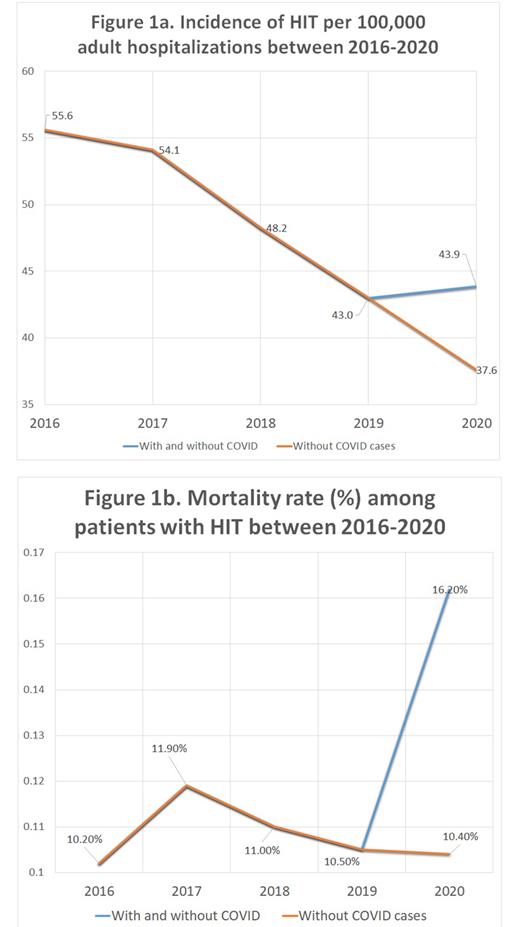Introduction: The recent pandemic of COVID-19 caused a significant upheaval in access to healthcare and resources across the world. The COVID-19 infection has also been associated with a hypercoagulable state that can alter multiple coagulation pathways and cause various cerebrovascular and cardiovascular insults, thus requiring the need for heparin products. While a recent study found a decreasing trend of Heparin-induced thrombocytopenia(HIT) between 2011-2014, there have yet to be any recent studies investigating the pandemic's role on HIT trends and the overall effect of COVID-19 on the mortality of these patients. We, therefore, used the National Inpatient Sample (NIS) to assess the impact of the pandemic on HIT.
Methods: The 2016-2020 NIS, a set of yearly discharge records released in de-identified form with various patient characteristics, discharge and procedural codes, was used for our study. We included cases with a diagnosis for HIT via the International Classification of Diseases, Tenth Revision (ICD-10) code “D7582”. Patients with COVID-19 and other comorbidities that can influence the outcomes were also identified via their respective ICD-10 codes from past studies. The incidence of HIT per 100,000 hospitalizations between 2016-2020 was compared and linear-by-linear analysis was used to assess trends, as in previous studies. We further proceeded to compare the trends in mortality rates among HIT patients. Finally, the odds of mortality among HIT patients with and without COVID-19, restricting the sample to HIT patients from 2020, were estimated via multivariable regression models. SPSS 29.0 was used for our analyses, and a p-value <0.05 was set for statistical significance.
Results: Our study included a total of 72930 cases of HIT between January 1st 2016- December 31st 2020, with 16780 cases in 2016, 16450 cases in 2017, 14590 cases in 2018, 12980 cases in 2019, and 12130 cases in 2020. The overall adjusted incidence of HIT dropped between 2016-2019 from 55.6 cases per 100,000 (in 2016) hospitalizations to 43.0 cases per 100,000 hospitalizations (in 2019). However, a rise was seen in 2020 with 43.9 cases per 100,000 hospitalizations (ptrend<0.01). On average, HIT was reported in 49.1 cases per 100,000 adult hospitalizations.
However, in 2020, among the 12130 cases of HIT, there were 1745(14.4%) COVID-19 positive patients. The adjusted incidence of HIT in 2020 without COVID-19 cases of HIT was 37.6 cases per 100,000 hospitalizations. The adjusted analysis (excluding COVID-19 positive HIT cases), showed a continuous decrease in incidence of HIT between 2016-2020 (Figure 1a).
Meanwhile, the mortality rates among HIT patients were 10.2% in 2016, 11.9% in 2017, 11.0% in 2018, 10.5% in 2019 and 16.2% in 2020 (ptrend<0.01). However, in 2020 the mortality rate among non-COVID-19 positive HIT patients was 10.4%, with no statistical differences between the years (ptrend=0.440) (Figure 1b).
Finally, among the HIT cases of 2020, concurrent presence of COVID-19 was linked with a higher odds of mortality (50.4% vs. 10.4%, aOR 8.471, 95% CI 7.405-9.690, p<0.01).
Conclusion: Our study provides a fresh analysis of the burden of the COVID-19 pandemic on the incidence and outcomes of HIT in the United States. While a decreasing incidence of HIT was seen between 2016-2020 for cases without COVID-19, in 2020, patients with the virus contributed to a rise in the overall incidence and mortality rates. COVID-19 infection has a massive impact on coagulation profiles, and while our data covers the pre-vaccination period, we strongly advocate for research via future NIS databases to better understand the progress of the pandemic on HIT in 2021 and onwards.
Disclosures
No relevant conflicts of interest to declare.


This feature is available to Subscribers Only
Sign In or Create an Account Close Modal